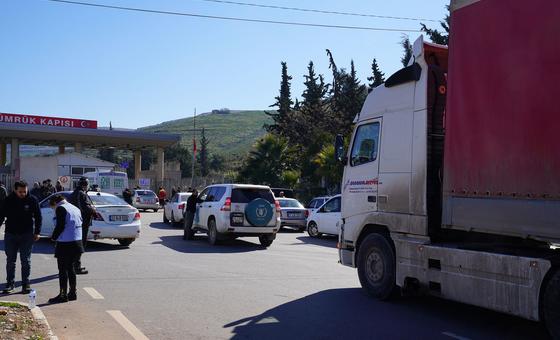Since 9 February, 143 trucks have passed through the Bab al-Hawa and Bab al-Salam border crossings, according to the UN Office for the Coordination of Humanitarian Affairs (OCHA). “The movements continue today, they continue over the weekend and will continue every day for as long as the needs are there,” OCHA spokesperson Jens Laerke told journalists in Geneva.
Asked about earthquake damage to roads leading to the aid corridors, the OCHA spokesperson referred to information that “all the roads through all the crossing points are passable and you can drive there…I was myself at Bab al-Hawa a few days ago and the trucks were indeed rolling across”.
Amid massive devastation in both Türkiye and Syria after the double quake strike on 6 February, relief workers continue to stress that the full extent of disaster is still unfolding. Echoing that message, the UN Food and Agriculture Organization (FAO) warned on Thursday that earthquake damage in Syria threatens “immediate and longer-term food security” in Syria.
In Türkiye, it’s estimated that more than 15 million people have been affected, while in Syria, 8.8 million have been impacted. Humanitarian assistance is urgently needed, as relief teams have seen first-hand in Aleppo, particularly after more than a decade of war.
Cracks in buildings – and people
“I was quite overwhelmed by not only the magnitude of the destruction but the loss that was inflicted on families, you know, during only 60 seconds,” said Fabrizio Carboni, International Committee of the Red Cross (ICRC) Regional Director for the Near and Middle East.
“For the first time I saw that there was not only a crack, and cracks in the buildings, but for the first time I really saw that our colleagues, the people you talked to in Syria, they were really wounded, and something is broken.”
Aid blocked from Damascus
Speaking to journalists in Geneva, the ICRC official also issued a strong appeal for crossline aid deliveries from Damascus to be allowed through to the largely opposition-held northwest: “We tried to get into Idlib through crossline and so far we’ve been blocked, unfortunately. So, I don’t have first-hand information on the roads and access but we’re ready to get in but we are so far blocked to do crossline, hoping that this could change soon.”

Families displaced by the earthquake are temporarily being accommodated in tents in Aziz, Syria.
Hot meals, family rations
As part of the UN-wide response, the World Food Programme (WFP) reported on Thursday that it has stepped up its emergency response to nearly half a million quake-affected people in Türkiye and Syria, providing hot meals, emergency ready-to-eat food packages and family food rations.
“Families tell me they left everything behind when the earthquake hit, running for their lives. WFP’s food is a lifeline for them; while they think about their next steps in the destruction left by the earthquake, their children can eat,” said Corinne Fleischer, WFP Regional Director for the Middle East, North Africa and East Europe.
She added: “We have scaled up rapidly and requests for more food are coming every day from municipalities and communities. We are there for them, but WFP can’t do it alone. We urgently appeal for funding to help us reach those in need.”
Averting a health disaster
Needs remain massive but the international response is gaining momentum, both in Türkiye and Syria, confirmed Caroline Holt, global director for operations at The International Federation of Red Cross and Red Crescent Societies (IFRC):
“In Türkiye, we’re very much supporting with the Turkish Red Crescent on the ground to support with shelter needs, with food, with wash, with health and also with cash.”
In Syria, the IFRC is working with the Syrian Arab Red Crescent to support people with basic needs and household items, including health, psychosocial support and clean water. With cholera already present in Syria, access to safe water “is absolutely critical to avoid that second potential disaster, that second health disaster unfolding”, Ms. Holt said.
UN-led flash appeals for both countries have been issued this week – a $1 billion request for Türkiye to help 5.2 million people for three months and a $397 million humanitarian appeal for nearly five million people in Syria – jumpstarted by a $50 million funding injection from the UN’s Central Emergency Response Fund.
Farming communities badly hit, too
Highlighting the need for sustained assistance in the region, the UN Food and Agriculture Organization (FAO) stressed that more help was needed for farming communities impacted by the crisis.
They are still reeling from the disaster, not least those who have opened their homes to survivors from nearby towns and cities.
Urgent needs include assessing the extent of damage to agriculture and food supply chains, including irrigation systems, roads, markets and storage capacity.
Food security threat long-term
In Syria, worrying early indications suggest major disruption to crop and livestock production capacity which threaten “immediate and longer-term food security”, FAO said.
“This includes damage and loss to livestock, agricultural equipment and infrastructure such as greenhouses, irrigation, storage facilities, as well as food and feed production facilities, among others.”
To support and help rural communities reinstate basic food production, FAO noted that its priority activities included supplying animal feed, seed, seedlings, fertilizer, fuel, tools, equipment, livestock vaccination and unconditional cash transfers for one to three months.
Job support in Türkiye
In Türkiye, FAO has supported displaced and host community families affected by the earthquakes too, with a focus on supporting jobs. The FAO Syria Refugee Resilience Plan aims to support 250,000 people with $71.8 million in funding.

